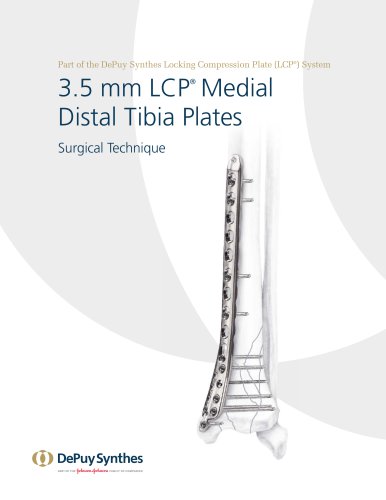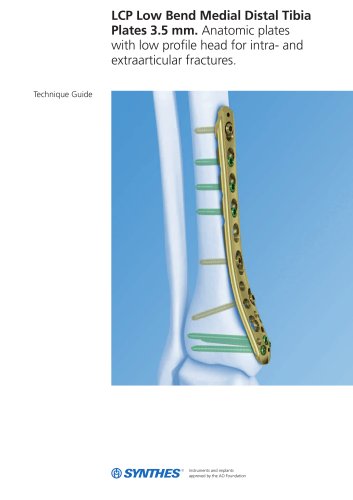
Catalog excerpts

Variable Angle LCP Dorsal Distal Radius Plate 2.4. For fragment-specific fracture fixation with variable angle locking technology. This publication is not intended for distribution in the USA. Instruments and implants approved by the AO Foundation. DePuy Synthes PART OF THE FAMILY OF COMPANIES
Open the catalog to page 1
Image intensifier control This description alone does not provide sufficient background for direct use of DePuy Synthes products. Instruction by a surgeon experienced in handling these products is highly recommended. Processing, Reprocessing, Care and Maintenance For general guidelines, function control and dismantling of multi-part instruments, as well as processing guidelines for implants, please contact your local sales representative or refer to: http://emea.depuysynthes.com/hcp/reprocessing-care-maintenance For general information about reprocessing, care and maintenance of Synthes...
Open the catalog to page 2
Introduction Variable Angle LCP Dorsal Distal Radius Plate 2.4 2 Surgical Technique Recommendations on Screw and Plate Insertion 8 Screw Insertion Techniques 8 Screw Type Determination 9 Plate Insertion Technique 10 Postoperative Treatment / Implant Removal 25 Variable Angle LCP Dorsal Distal Radius Plate 2.4 Surgical Technique DePuy Synthes
Open the catalog to page 3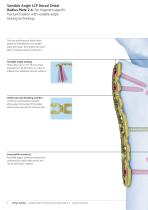
Variable Angle LCP Dorsal Distal Radius Plate 2.4. For fragment-specific fracture fixation with variable angle locking technology. The low profile dorsal distal radius plates are intended for the double- plate technique. All implants are available in stainless steel and titanium. Variable angle locking Holes allow up to 15° off-axis screw a ngulation in all directions in order to a ddress the individual fracture patterns. Undercuts and bending notches Undercuts and bending notches a llow easy contouring of the plates while preserving the VA locking holes. Low profile construct...
Open the catalog to page 4
Anatomical fit Anatomical pre-contoured plates for the radial and intermediate column minimize the need for bending. Oblong VA combi-hole Allows accurate plate positioning on the bone. Kirschner wire holes Enable preliminary plate fixation. Variable Angle LCP Dorsal Distal Radius Plate 2.4 Surgical Technique DePuy Synthes
Open the catalog to page 5
In 1958, the AO formulated four basic principles, which have In 1958, the guidelines for internalbasic principles, which AO formulated four fixation1,2. become have become the guidelines for internal xation1, 2. Anatomic reduction Anatomic Fracture reduction and xation Fracture reduction and fixation to to restore anatomical relationships. restore anatomical relationships. 1 Early, Early, active mobilization mobilization Early and Early and safe mobilization and mobilization and rehabilitation of the injured part and rehabilitation the injured part the the patient as a whole. and patient as...
Open the catalog to page 6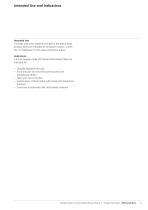
Intended Use The plate and screw implants included in the Radius Plate product family are intended for temporary fixation, correction or stabilization in the radius anatomical region. Indications 2.4 mm Variable Angle LCP Dorsal Distal Radius Plates are indicated for: –– Dorsally displaced fractures –– Extra-articular and intra-articular fractures with metaphyseal defect –– Open joint reconstruction –– Combination of distal radius with carpal and metacarpal fractures –– Corrective osteotomies after distal radius malunion Variable Angle LCP Dorsal Distal Radius Plate 2.4 Surgical Techniqu
Open the catalog to page 7
Clinical Cases Case 1 69-year-old female with AO 23A2 fracture Preoperative, lateral view Postoperative, lateral view Preoperative, lateral view Postoperative, lateral view Case 2 59-year-old male with AO 23C2 fracture 6 DePuy Synthes Variable Angle LCP Dorsal Distal Radius Plate 2.4 Surgical T
Open the catalog to page 8
Three-Column Theory The treatment of distal radius fractures requires a meticulous reconstruction of the joint surface, as well as stable internal fixation and early functional postoperative treatment. Extra-articular fractures require both the restoration of the volar tilt and radial length to reduce the possibility of displacement. Any malalignment may result in limitations of movement, changes of load distribution, mid-carpal instability as well as the increased risk of osteoarthritis in the radiocarpal joint. Intra-articular fractures with articular displacement of more than 2 mm in the...
Open the catalog to page 9
Recommendations on Screw and Plate Insertion Screw Insertion Techniques Variable angle locking screws can be inserted using two different techniques: – Variable angle technique – Pre-defined nominal angle technique Funnel-shaped end for offaxis drilling Fixed-angle end for nominal angle drilling VA-LCP Drill Sleeve (03.110.000) VA-LCP Drill Sleeve, freehand (03.111.004), for off-axis drilling a) Variable angle technique To drill variable angle holes up to 15° deviation from the nominal trajectory of the locking hole, insert the tip of the VA-LCP drill sleeve and key into the cloverleaf...
Open the catalog to page 10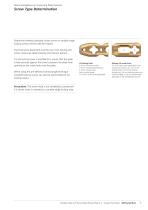
Recommendations on Screw and Plate Insertion Screw Type Determination Determine whether standard cortex screws or variable angle locking screws will be used for fixation. The final screw placement and the use of VA locking and cortex screws are determined by the fracture pattern. If a VA locking screw is inserted first, ensure that the plate is held securely against the bone to prevent the plate from spinning as the screw locks into the plate. When using the pre-defined nominal angle technique s tandard locking screws can also be used instead of VA locking screws. VA locking hole: 2.4 mm...
Open the catalog to page 11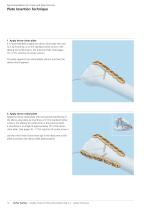
Recommendations on Screw and Plate Insertion Plate Insertion Technique 1. Apply dorso-ulnar plate It is recommended to apply the dorso-ulnar plate first and fix it by inserting a 2.4 mm standard cortex screw in the o blong VA combi-hole in the proximal shaft. (See pages 16 –17 for insertion of cortex screws.) The plate supports the intermediate column and fixes the dorso-ulnar fragment. 2. Apply dorso-radial plate Apply the dorso-radial plate after provisional positioning of the dorso-ulnar plate by inserting a 2.4 mm standard cortex screw in the oblong VA combi-hole in the proximal...
Open the catalog to page 12All Depuy Synthes catalogs and technical brochures
-
2.0 mm LCP® Distal Ulna Plate
20 Pages
-
Building on Success
16 Pages
-
RADIUS OF CURVATURE
3 Pages
-
Introducing The Variable Angle
12 Pages
-
HEALIX Anchor™ 3.4 mm
2 Pages
-
Small Battery Drive II
4 Pages
-
HEALIX ADVANCE
4 Pages
-
3.5 mm LCP™ Medial
15 Pages
-
Titanium Sternal Fixation System
34 Pages
-
MatrixRIB®FixationSystem
86 Pages
Archived catalogs
-
2.4 mm VA LCP™
4 Pages
-
Mandible Trauma Solutions
2 Pages
-
Power line II
4 Pages
-
Concorde
28 Pages
-
LCP Intercarpal
31 Pages
-
LCS® COMPLETE™
2 Pages
-
Synthes TPLO.
8 Pages
-
SynFix-LR System
56 Pages
-
ATB Anterior Tension Band Plate
32 Pages
-
CONDUIT™
15 Pages
-
Brochure_FINAL
2 Pages
-
DePuy Synthes
81 Pages
-
Anspach
3 Pages
-
Orthopedic Foot Instruments
32 Pages
-
PINNACLE® Hip Solutions
12 Pages
-
Corail
24 Pages
-
S-ROM® NOILES™
68 Pages
-
TRI-LOCK® Product Rationale
12 Pages
-
Reclaim Surgical Technique
44 Pages
-
Speed
2 Pages
-
attune
80 Pages
-
HAMMERLOCK® 2
2 Pages
-
DePuy Glenoid Solutions
2 Pages
-
Trauma Solutions. Elbow
4 Pages
-
Polar
4 Pages
-
Alveolar Distractor.
4 Pages
-
Piezoelectric System
4 Pages
-
Air Power Line II
6 Pages
-
LCP Clavicle Hook Plate
4 Pages
-
TruMatch Pin Guides
16 Pages
-
P F N A
8 Pages
-
SKILL, DEDICATION,
16 Pages
-
Orthopaedics. Overview
20 Pages
-
DURALOC
16 Pages
-
Marathon Cemented Cup
20 Pages
-
REEF Surgical Technique
16 Pages
-
MatrixNEURO
8 Pages
-
Anspach XMax
4 Pages
-
Anspach eMax 2 Plus
4 Pages
-
Small Electric Drive
4 Pages
-
Air Pen Drive
4 Pages
-
Colibri II
4 Pages
-
Spine
25 Pages
-
Expert Hindfoot Arthrodesis Nail
48 Pages
-
LCP Distal Fibula Plates
32 Pages
-
TomoFix
60 Pages
-
Expert Tibial Nail PROtect
16 Pages
-
Expert Tibia Nail
84 Pages
-
Sacral Bars
16 Pages
-
Pelvic C-Clamp
20 Pages
-
Low Profile Pelvic System
16 Pages
-
Proximal Femoral (Hook) Plate
24 Pages
-
LCP
24 Pages
-
PFNA
112 Pages
-
HCS 1.5, 2.4, 3.0
36 Pages
-
LCP Wrist Fusion
32 Pages
-
LCP Compact Hand
28 Pages
-
VA-LCP Elbow
48 Pages
-
Distal Radius
44 Pages
-
Olecranon
30 Pages
-
LCP Hook Plate
28 Pages
-
DHP & Olecranon
4 Pages
-
LCP S-A
4 Pages
-
Epoca
4 Pages
-
Philos
32 Pages
-
MultiLoc
68 Pages










